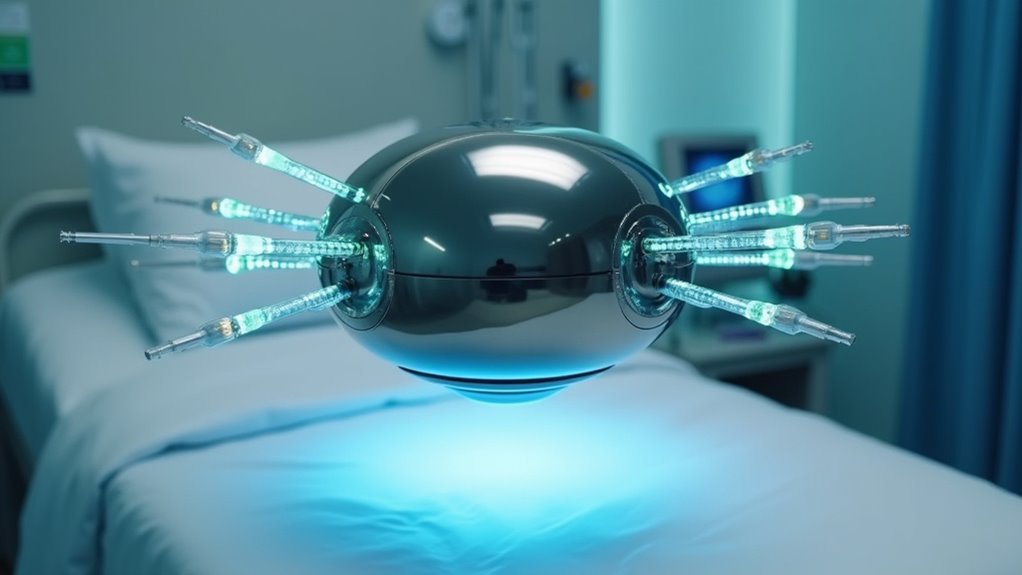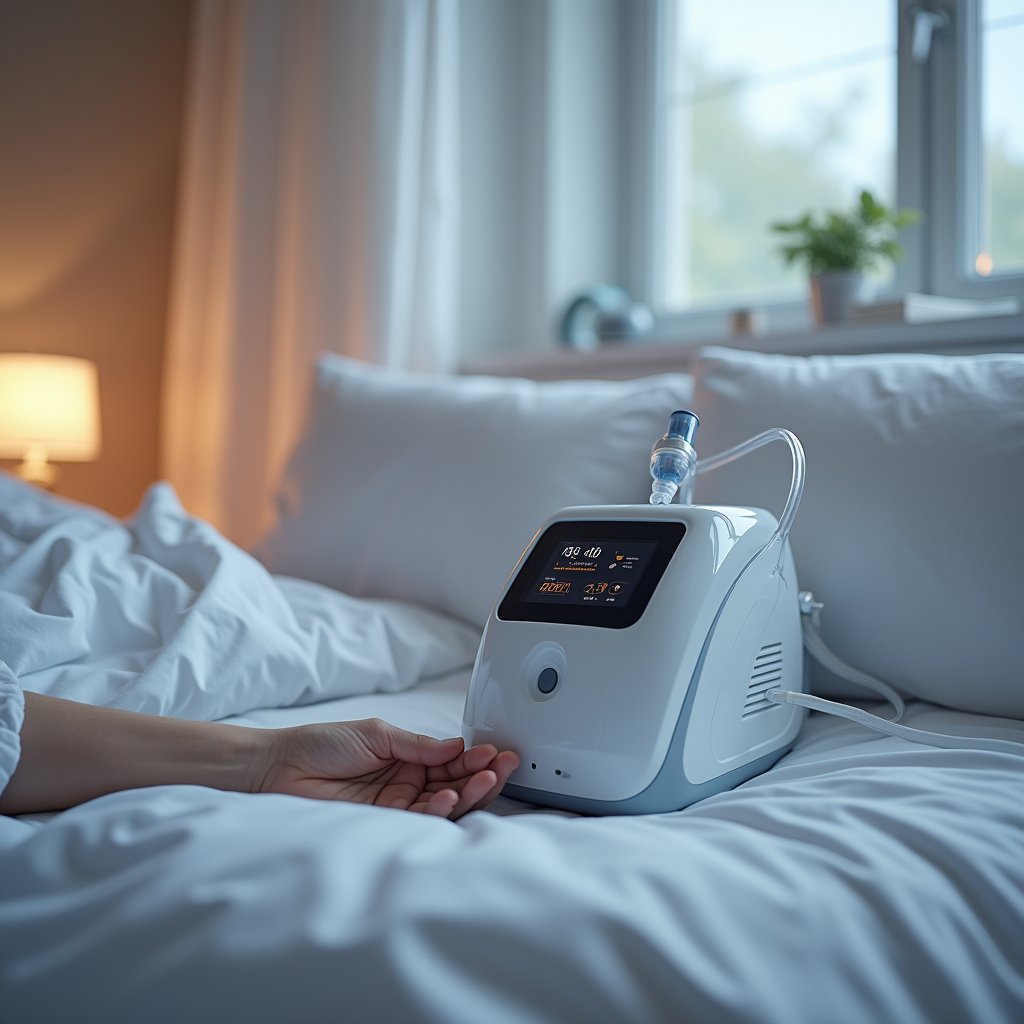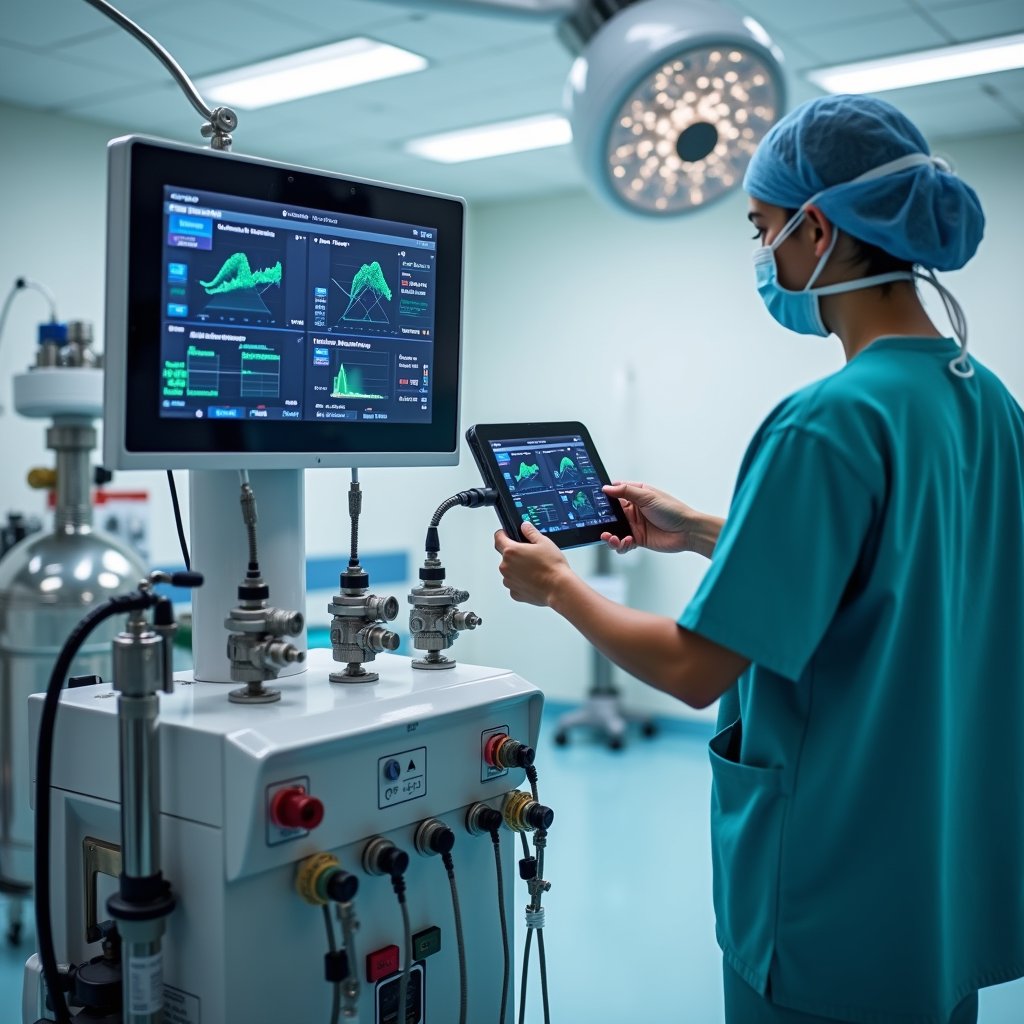Medical nitrous oxide innovations will transform healthcare delivery by 2025 through IoT-enabled smart systems, precision monitoring, and patient-controlled solutions. You’ll see widespread adoption of cloud-based analytics platforms, advanced safety protocols, and sustainable production methods. The market’s projected growth to $2.37 billion reflects increasing demand for portable units and home-based care options. New developments in telemedicine integration and precision dosing will revolutionize pain management – these emerging trends signal a pivotal shift in medical gas administration.
Smart Delivery Systems and IoT Integration

Smart delivery systems for nitrous oxide have evolved considerably, incorporating cutting-edge IoT technology and precision monitoring capabilities. You’ll find the INOmax EVOLVE DS exemplifies this advancement through its synchronized dosing mechanisms and real-time therapeutic gas monitoring, ensuring consistent NO concentration delivery throughout the breathing cycle. The market’s expansion to market size of $2.37 billion by 2025 reflects growing adoption of these sophisticated delivery systems. The system’s versatility extends across multiple healthcare settings, including dental clinics and surgical centers, making it an essential medical tool.
Cloud-based data management now enables healthcare providers to track treatment efficacy and make data-driven decisions through integrated hospital IT infrastructure. The systems offer enterprise-level interoperability, connecting with existing critical care equipment while providing automated deviation alerts and predictive analytics. The growing demand for these advanced systems is driven by the rising prevalence of chronic pain conditions, affecting nearly a quarter of U.S. adults.
You’re getting augmented safety features through built-in protocols and automated thresholds, while machine learning algorithms optimize dosing based on patient-specific data. Remote monitoring solutions allow for continuous oversight, making treatment adjustments more responsive and precise than ever before.
Home-Based Pain Management Solutions

You’ll find that remote monitoring capabilities are revolutionizing home-based nitrous oxide delivery through integrated IoT sensors that track usage patterns and efficacy in real-time.
The emergence of mobile treatment platforms has reduced traditional clinical costs by up to 40%, while maintaining professional oversight through telemedicine connections. Unlike dental nitrous oxide applications, these systems offer patient-controlled dosing for optimal comfort levels. These technological advances enable you to access professional-grade pain management solutions from home, supported by automated safety protocols and continuous digital monitoring systems. The patient-controlled design ensures maximum comfort and safety with a proven 50/50 blend ratio that allows individuals to self-administer based on their needs. The advanced delivery system provides fast-acting relief while allowing patients to safely resume their daily activities shortly after use.
Remote Monitoring Innovations
As healthcare systems increasingly adopt home-based pain management solutions, remote monitoring innovations for nitrous oxide administration have revolutionized patient care through advanced sensor technologies and wireless connectivity. You’ll find personalized analytics dashboards integrating with NDIR sensors to deliver real-time N₂O concentration data, while adaptive patient notification systems guarantee immediate alerts when safety thresholds are breached. The new remote monitoring systems employ infrared sensing technology to detect nitrous oxide molecules with exceptional accuracy. NHS Elect supported guidance will help medical facilities implement these monitoring solutions starting in early 2025. The growing global market, projected to reach USD 3.2 billion by 2030, is driving rapid development of these monitoring technologies.
| Feature | Technology | Benefit |
|---|---|---|
| Detection | NDIR Sensors | Real-time N₂O monitoring |
| Connectivity | IoT Integration | Remote provider access |
| Safety | Automated Protocols | Compliance tracking |
These innovations enable healthcare providers to remotely monitor patient safety, maintain regulatory compliance, and optimize treatment outcomes. The system’s environmental tracking capabilities assure responsible N₂O usage while supporting carbon credit initiatives through precise emission monitoring and waste reduction measurements.
Cost-Effective Delivery Solutions
Recent innovations in home-based nitrous oxide delivery systems have transformed pain management through cost-effective, patient-controlled solutions. Like Pro-Nox nitrous systems, these options allow patients to self-administer medication safely at home. The system’s demand flow delivery ensures precise administration for maximum comfort and safety. These advancements align with customized financing options and payer reimbursement strategies, revolutionizing accessibility for patients. Patients remain fully awake and responsive throughout the self-administration process, ensuring they maintain control of their treatment.
Key cost-reduction features include:
- Portable self-administration devices with demand-flow mechanisms, reducing staff dependency and operational expenses
- Modular designs with standardized 50/50 N₂O/O₂ ratios, optimizing cylinder replacement and maintenance costs
- FDA-cleared systems that utilize insurance partnerships, enhancing coverage eligibility while minimizing out-of-pocket expenses
The integration of Mini Vacuum Systems and compact storage solutions further streamlines home implementation. With proven clinical success across specialties and reduced hospitalization risks, these systems demonstrate compelling cost advantages over traditional sedative-based approaches, making them an economically viable choice for both providers and patients.
Mobile Treatment Platforms
Driven by the rising prevalence of chronic pain among U.S. adults, mobile nitrous oxide treatment platforms have emerged as a transformative solution for home-based pain management. You’ll find customized modular systems like Nitrouseal and Nitronox leading this evolution with FDA-cleared, self-administered units that integrate seamlessly with existing medical infrastructure. The advanced digital flow meters allow for adjustable precise dosages tailored to each patient’s unique requirements. Technological advancements have enabled these systems to achieve a market value of 2.15 billion dollars in 2024.
These platforms feature integrated power sources and built-in waste gas scavenging capabilities that connect to wall vacuums or WAGD outlets, ensuring OSHA compliance in home settings. The emphasis on safety features has led to enhanced monitoring systems and improved user-friendliness in newer models. You can control your pain management through demand-flow systems that maintain a fixed 50/50 N2O/O2 ratio, while sensors and alarms monitor gas flow for your safety.
The systems’ instant onset/offset characteristics and minimal recovery time make them particularly effective for ongoing home care needs.
Enhanced Safety Protocols and Monitoring

Modern healthcare facilities have revolutionized nitrous oxide safety through detailed monitoring systems and rigorous protocols. Digital logging systems now track real-time exposure levels, while predictive maintenance models guarantee equipment reliability and prevent system failures.
You’ll find these critical safety advancements in today’s N₂O administration:
- Advanced gas detection systems that continuously monitor ambient levels and trigger alerts when concentrations exceed 25 ppm NIOSH limits
- Demand valve mechanisms featuring negative-pressure activation and fixed 50/50 N₂O/O₂ blends
- Heightened scavenging systems with closed-loop technology that captures non-inhaled gases
These integrated safety measures work alongside strict documentation requirements and staff training programs. With automated monitoring and multi-layer redundancies, you’re assured that every N₂O administration meets the highest safety standards while maintaining therapeutic effectiveness.
Expansion Into Emerging Healthcare Markets
As global healthcare demands evolve, nitrous oxide applications have expanded beyond traditional hospital settings into diverse market segments. You’ll find this medical gas increasingly utilized in dental clinics and veterinary facilities, driven by rising procedure volumes and growing pet healthcare expenditures.
The expansion extends into emerging markets through public-private partnerships, particularly in low- and middle-income countries where healthcare infrastructure development is gaining momentum. Community-based outreach programs are facilitating adoption in rural areas, while mobile surgical units and emergency medical services integrate portable delivery systems for edge-case scenarios.
You’re also seeing integration with alternative pain management modalities and telehealth platforms, creating new opportunities in chronic pain clinics and remote healthcare delivery. This market diversification is supported by targeted training programs and regional manufacturing hubs to guarantee cost-effective distribution.
Sustainable Production and Distribution Methods
You’ll find that sustainable nitrous oxide production increasingly relies on green manufacturing processes that minimize waste and environmental impact.
Supply chain optimization networks are revolutionizing distribution through AI-powered logistics and real-time tracking systems that reduce transportation emissions by up to 30%.
Modern eco-friendly storage solutions incorporate renewable energy systems and advanced containment technologies to maintain product integrity while lowering the carbon footprint across the supply chain.
Green Manufacturing Processes
Recent innovations in green manufacturing processes for nitrous oxide production have revolutionized traditional methods while substantially reducing environmental impact. Through advanced carbon footprint management and strategic green energy procurement, medical facilities can now achieve unprecedented efficiency in N₂O production.
Chemical industry abatement technologies have demonstrated potential to reduce emissions by over 40%, marking a significant advancement in sustainable manufacturing.
Catalytic conversion systems now enable facilities to minimize greenhouse gas emissions while maintaining production quality.
Integration of renewable energy sources in manufacturing processes has decreased the overall environmental impact, contributing to the industry’s goal of reducing its 7% share of U.S. emissions.
These developments signal a transformative shift in the direction of environmentally conscious production methods, positioning the medical gas industry at the forefront of sustainable healthcare solutions.
Supply Chain Optimization Networks
Building upon sustainable manufacturing advances, modern supply chain optimization networks have transformed nitrous oxide distribution through integrated AI and IoT technologies. You’ll find data-driven forecasting models revolutionizing inventory management, with real-time consumption tracking reducing stockouts by implementing predictive analytics and dynamic scheduling systems.
Circular economy initiatives now define distribution partnerships, as you’re seeing healthcare facilities adopt shared responsibility models for cylinder management and recycling. These networks utilize blockchain technology for transparency while utilizing digital twin simulations to optimize delivery routes. Regional collaborations are maximizing logistics efficiency through shared infrastructure, while IoT-enabled cylinders provide real-time tracking.
The implementation of these systems has demonstrated significant cost savings, with redundant system removal saving £700K in Scotland, while maintaining strict ISO and FDA compliance standards.
Eco-Friendly Storage Solutions
Several breakthrough innovations in eco-friendly storage solutions have revolutionized nitrous oxide containment through advanced cryogenic systems and sustainable infrastructure. Cryogenic storage optimization has transformed traditional storage methods by reducing waste and emissions while maximizing gas retention efficiency.
Material sustainability initiatives have yielded remarkable improvements:
- Fire-rated structures utilizing recycled steel and low-carbon concrete reduce environmental impact while meeting safety standards
- Modular designs with advanced insulation materials minimize construction waste and temperature fluctuations
- Automated ventilation systems with smart sensors optimize energy usage while preventing gas leaks
You’ll find these eco-friendly solutions particularly effective when implementing co-storage methods, where shared infrastructure reduces land use and transportation energy. The integration of sustainable materials and efficient systems aligns with NFPA 99 standards while considerably lowering your facility’s environmental footprint.
Advanced Dental Applications and Technology
Technological advancements in nitrous oxide administration have revolutionized dental practices, with the market projected to reach $2.37 billion by 2025. You’ll find improved delivery systems integrating digital monitoring capabilities and precise dosing controls, transforming how dental professionals manage patient sedation.
New training curriculums at institutions like Boston University and DOCS Education emphasize hands-on experience with these advanced systems. Their programs focus on dental staff onboarding, covering everything from safety protocols to emergency response procedures. You’ll need to master real-time monitoring devices and documentation systems that sync with electronic health records.
The integration of these technologies responds to growing patient demand for non-invasive sedation options while meeting stringent regulatory requirements. State-specific licensing mandates now drive the development of standardized qualification processes across dental practices.
Mobile Medical Services and Portable Units
Modern portable nitrous oxide systems have transformed mobile medical services through advanced safety features and versatile administration options. Improved mobility features now include FDA-cleared MINISCAV® technology and integrated scavenging systems, enabling streamlined deployment logistics across diverse medical settings.
Portable nitrous oxide systems revolutionize mobile healthcare with enhanced safety features and FDA-approved technology for seamless medical deployment.
Key advancements driving market growth include:
- Automated safety controls with preset 50/50 N₂O/O₂ mixtures and oxygen-driven pressure monitoring
- Versatile administration options featuring three interchangeable masks and digital flowmeters
- EMS integration capabilities supporting on-site pain management during patient transport
You’ll find these innovations particularly valuable as the market expands by $2.37 billion by 2025. The shift to non-opioid solutions, combined with compact designs and all-in-one waste management, positions portable nitrous oxide systems as essential tools in mobile healthcare delivery.
Precision Dosing and Patient-Specific Administration
AI-powered flow control systems enable you to achieve unprecedented precision in nitrous oxide delivery through real-time analysis of patient essential and procedural requirements.
You’ll find that smart biometric monitoring systems automatically adjust dosage levels by continuously analyzing multiple physiological parameters, including heart rate, blood pressure, and oxygen saturation. These intelligent systems can predict and respond to patient needs more rapidly than traditional manual adjustments, resulting in optimized therapeutic outcomes and reduced recovery times.
AI-Guided Flow Control
Rapidly evolving precision dosing systems now integrate real-time monitoring with adaptive control mechanisms for nitrous oxide administration. Next generation embedded sensors enable multi-modal physiological tracking, transforming how you’ll manage patient care through AI-powered flow adjustments.
Key advances in AI-guided flow control include:
- Real-time modifications based on muscle oxygenation (SmO2) and nitric oxide data streams, achieving 90% accuracy in predicting release patterns
- Machine learning algorithms that continuously recalibrate dosing curves using historical and live patient data
- Automated safety overrides that trigger immediate alerts when deviations exceed predefined thresholds
These systems combine operational data integration with pharmacokinetic modeling to optimize delivery rates while maintaining precise control over gas concentrations. Vision-based anomaly detection further augments safety by identifying equipment misuse or improper administration routes.
Smart Biometric Dose Adjustment
Building upon AI-guided flow systems, smart biometric dose adjustment represents the next frontier in nitrous oxide administration. You’ll see personalized delivery algorithms integrating patient-specific factors like cardiovascular risk profiles and weight-based calculations to determine ideal dosing parameters.
Advanced delivery systems now pair continuous biometric monitoring with automated feedback loops, allowing real-time adjustments based on respiratory rates and oxygen saturation levels. These platforms synchronize with ventilator cycles while tracking exhaled breath composition through smart mask sensors. You’ll find proprietary technologies maintaining precise gas concentrations throughout treatment sessions, considerably reducing human error compared to manual methods.
This evolution in precision dosing addresses historical safety concerns, particularly for specialized populations like psychiatric patients and those undergoing extended procedures, while maintaining strict regulatory compliance with FDA-mandated safety thresholds.
Regulatory Compliance and Quality Standards
Three major regulatory shifts have transformed the compliance environment for nitrous oxide in 2024-2025. You’ll find strengthened interoperability frameworks and regulatory compliance audits shaping the industry, with FDA’s extensive oversight of medical gas production and distribution taking center stage.
Evolving FDA oversight and enhanced compliance frameworks redefine nitrous oxide regulations, marking a pivotal shift in industry standards for 2024-2025.
Key developments include:
- Mandatory GMP compliance and real-time tracking systems for all medical-grade production facilities
- Implementation of secure packaging requirements and licensed vendor restrictions to prevent unauthorized access
- Integration of quality control audits with FDA-approved production standards
These changes align with new state-level enforcement measures, particularly around age limitations and sales prohibitions. You’ll need to adapt to stricter protocols, especially if you’re handling flavored products, as regulators crack down on marketing loopholes while maintaining exemptions for legitimate medical and industrial applications.
Telemedicine Integration and Remote Care Solutions
While traditional medical settings once dominated nitrous oxide administration, telemedicine platforms have revolutionized its delivery through sophisticated remote monitoring systems. You’ll find 5G infrastructure integration enabling real-time critical sign tracking and immediate specialist support during procedures, particularly for prostate biopsies and other minimally invasive interventions.
Remote procedure simulations now provide standardized training protocols, ensuring consistent administration across decentralized care networks. You’re seeing improved safety profiles through preserved airway reflexes and continuous cardiovascular monitoring, all while reducing on-site staffing requirements.
Cost-effective telehealth solutions optimize resource allocation and streamline post-procedural follow-ups within 3-5 minutes of recovery. The integration of virtual platforms with remote patient monitoring represents a significant advancement in accessible, efficient healthcare delivery while maintaining rigorous safety standards.
Frequently Asked Questions
What Are the Long-Term Environmental Impacts of Increased Nitrous Oxide Production?
You’ll see severe environmental consequences from rising N₂O emissions, with two major impacts.
Initially, as the primary ozone-depleting substance still in use, N₂O greatly threatens the stratospheric ozone layer’s recovery.
Second, since it’s 270-300 times more potent than CO₂, increased greenhouse gas emissions from N₂O accelerate global warming dramatically. The compound’s long atmospheric persistence means these effects will continue impacting Earth’s climate systems for decades to come.
How Does Nitrous Oxide Affect Fertility and Reproductive Health?
If you’re exposed to nitrous oxide regularly, you’ll face significant reproductive health risks. The gas can disrupt your endocrine system and interfere with DNA synthesis, potentially reducing fertility in both men and women.
You’ll find it particularly concerning if you’re a healthcare worker, as occupational exposure is linked to spontaneous abortion and birth defects. Consider fertility preservation options if you’re chronically exposed, and guarantee proper protective measures are in place at your workplace.
Can Nitrous Oxide Be Safely Used During Pregnancy?
When used properly in medical settings, you can safely receive nitrous oxide during pregnancy, particularly during labor. Short-term exposure hasn’t shown significant fetal developmental risks in human studies.
However, you’ll need proper physician oversight and a 50/50 mix with oxygen to guarantee safe maternal breathing impacts. If you’re a healthcare worker, you should avoid prolonged occupational exposure during pregnancy due to increased risks of adverse outcomes.
What Are the Psychological Effects of Regular Nitrous Oxide Exposure?
Regular nitrous oxide exposure can severely impact your psychological well-being. You’ll likely experience memory impairment and cognitive decline, particularly affecting your concentration and decision-making abilities.
You’re at risk of developing psychological dependence, with increased tolerance requiring higher doses for the same effects. You may also face heightened anxiety, depression, and potential psychosis.
The neurotoxic effects worsen through B12 depletion, creating a harmful cycle of deteriorating mental health.
How Does Nitrous Oxide Interact With Common Prescription Medications?
You’ll need to be cautious about potential drug interactions when using nitrous oxide, especially with CNS depressants and opioids. It can markedly amplify the effects of benzodiazepines and antidepressants, potentially leading to excessive sedation.
You’re at particular risk when combining it with opioid medications, as this can cause dangerous respiratory depression. If you’re taking blood pressure medications or MAO inhibitors, you’ll need to discuss this with your healthcare provider due to unpredictable interactions.

